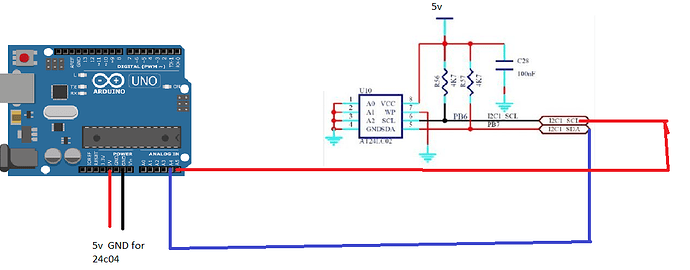hi , while reading only 255 number is coming . no stored in the eeprom . using the 24c04 .
#include "Wire.h"
// EEPROM I2C Address
#define EEPROM_I2C_ADDRESS 0x50
// Analog pin for potentiometer
int analogPin = 0;
// Integer to hold potentiometer value
int val = 0;
// Byte to hold data read from EEPROM
int readVal = 0;
// Integer to hold number of addresses to fill
int maxaddress = 150;
// Function to write to EEPROOM
void writeEEPROM(int address, byte val, int i2c_address)
{
// Begin transmission to I2C EEPROM
Wire.beginTransmission(i2c_address);
// Send memory address as two 8-bit bytes
Wire.write((int)(address >> 8)); // MSB
Wire.write((int)(address & 0xFF)); // LSB
// Send data to be stored
Wire.write(val);
// End the transmission
Wire.endTransmission();
// Add 5ms delay for EEPROM
delay(5);
}
// Function to read from EEPROM
byte readEEPROM(int address, int i2c_address)
{
// Define byte for received data
byte rcvData = 0xFF;
// Begin transmission to I2C EEPROM
Wire.beginTransmission(i2c_address);
// Send memory address as two 8-bit bytes
Wire.write((int)(address >> 8)); // MSB
Wire.write((int)(address & 0xFF)); // LSB
// End the transmission
Wire.endTransmission();
// Request one byte of data at current memory address
Wire.requestFrom(i2c_address, 1);
// Read the data and assign to variable
rcvData = Wire.read();
// Return the data as function output
return rcvData;
}
void setup()
{
// Connect to I2C bus as master
Wire.begin();
// Setup Serial Monitor
Serial.begin(9600);
// Print to Serial Monitor
Serial.println("Start Recording...");
// Run until maximum address is reached
for (int address = 0; address <= maxaddress; address++) {
// Read pot and map to range of 0-180 for servo
val = map(analogRead(analogPin), 0, 1023, 0, 180);
// Write to the servo
// Delay to allow servo to settle in position
delay(15);
// Record the position in the external EEPROM
writeEEPROM(address, val, EEPROM_I2C_ADDRESS);
// Print to Serial Monitor
Serial.print("ADDR = ");
Serial.print(address);
Serial.print("\t");
Serial.println(val);
}
// Print to Serial Monitor
Serial.println("Recording Finished!");
// Delay 5 Seconds
delay(5000);
// Print to Serial Monitor
Serial.println("Begin Playback...");
// Run until maximum address is reached
for (int address = 0; address <= maxaddress; address++) {
// Read value from EEPROM
readVal = readEEPROM(address, EEPROM_I2C_ADDRESS);
// Write to the servo
// Delay to allow servo to settle in position
delay(15);
// Print to Serial Monitor
Serial.print("ADDR = ");
Serial.print(address);
Serial.print("\t");
Serial.println(readVal);
}
// Print to Serial Monitor
Serial.println("Playback Finished!");
}
void loop()
{
// Nothing in loop
}
